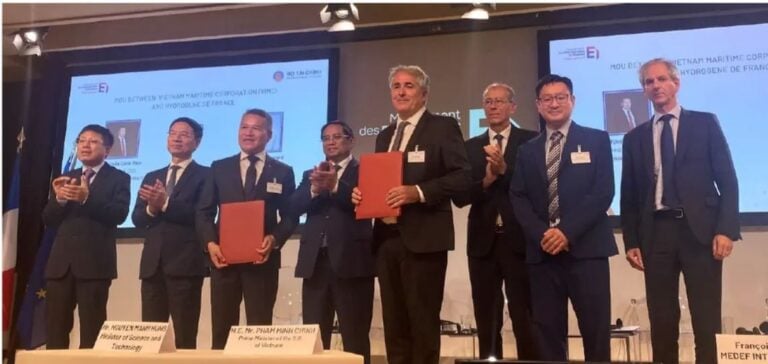HDF Energy and Vietnam Maritime Corporation (VIMC) signed a memorandum of understanding in Paris on 11 June aimed at fitting the Vietnamese fleet with green-hydrogen fuel cells. HDF Energy said on 12 June that the cooperation framework spans technical studies, pilot projects and the mobilisation of international financing. The agreement was signed by VIMC president Nguyen Canh Tinh and his counterpart at HDF Energy, Damien Havard, on the sidelines of the third United Nations Ocean Conference.
Political context
The ceremony gathered Vietnamese Prime Minister Pham Minh Chinh and several cabinet ministers, underscoring the strategic weight attached to decarbonising the sector. According to International Maritime Organization data published on 10 May 2024, global shipping accounts for roughly 3 % of annual greenhouse-gas emissions. Vietnam, with more than three thousand kilometres of coastline, relies heavily on seaborne trade for its external commerce. Pursuing a carbon-neutral target for 2050, Hanoi is now encouraging technologies capable of replacing heavy fuel oil.
Decarbonisation goals
The two partners will run real-world trials to assess the operational performance of HDF Energy’s high-power fuel cells on VIMC cargo vessels. The systems will be supplied with green hydrogen produced at Renewstable® plants currently under study in several Vietnamese provinces. HDF Energy, which assembles the stacks at its Blanquefort site, believes domestic production will cut logistics costs and stabilise supply. VIMC is simultaneously modernising its fleet with new-generation ships and plans to equip several ports with shore-power facilities.
Technology and financing
The memorandum also calls for the search of international funding, notably from development banks and climate mechanisms, to cover the purchase of propulsion systems and bunkering infrastructure. HDF Energy says its stacks are designed for outputs above two megawatts and can be retrofitted to existing vessels during major overhauls. Nguyen Canh Tinh stressed that the solutions “will accelerate VIMC’s net-zero roadmap by 2050”, while Damien Havard spoke of “a reproducible model for zero-carbon maritime transport across Southeast Asia”. Initial feasibility studies are scheduled for the second half of 2025, with demonstrators expected before 2028.
Regional outlook
Beyond Vietnam, the partnership could open the way for similar deployments at Southeast Asian ports, where green-hydrogen demand is forecast to grow by 15 % a year, according to BloombergNEF figures published on 4 April 2025. The signatories said that the normalisation of technical standards and the sharing of operational data will be integral to the programme. Vietnamese public stakeholders view the project as a catalyst for attracting further foreign investors into hydrogen production and storage infrastructure. Damien Havard reminded that “marine fuel-cell systems now have enough track record to move to commercial scale”.






















